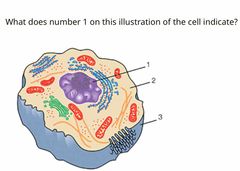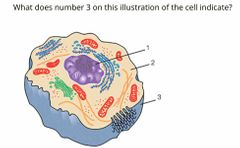![]()
![]()
![]()
Use LEFT and RIGHT arrow keys to navigate between flashcards;
Use UP and DOWN arrow keys to flip the card;
H to show hint;
A reads text to speech;
23 Cards in this Set
- Front
- Back
- 3rd side (hint)
|
Most of the activities of the cell take place in the |
Cytoplasm |
105E.1, p. 4 Most of the activities of the cell take place in the cytoplasm |
|
|
Groups of cells of the same kind make up: |
Tissues |
105E.1, p. 7 Groups of cells of the same kind make up tissues. |
|
|
What is another name for histology? |
Microscopic Anatomy |
105E.1, p. 4 Microscopic anatomy is another name for histology. |
|
|
The study of normal organ function and systems of the body is known as: |
Physiology |
105E.1, p. 4 The study of normal organ function and systems of the body is known as physiology. |
|
|
Which area of science involves the study of the organs and systems of the body? |
anatomy |
105E.1, p. 4 Anatomy is the study of the organs and systems of the body. |
|
|
Which primary organ of the lymphatic system filters old/non-functional red blood cells from the body? |
Spleen |
105E.1, p. 8 The spleen filters old/non-functional red blood cells from the body (lymphatic system). |
|
|
The process of building up larger molecules from smaller ones is |
Anabolism |
105E.1, p. 6 Anabolism is the process of building up larger molecules from smaller ones. |
|
|
True or false controlling the basic functions and activities of the cell is an example of metabolism? |
False |
105E.1, p. 6 Building up larger molecules from smaller ones, releasing energy to perform specific body functions and breaking down of larger molecules or substances into smaller ones are examples of metabolism. |
|
|
True or false The process of cell growth and division is called the growth cycle. |
False |
105E.1, p. 5 The process of cell growth and division is called the cell cycle |
|

Front (Term) |
Cytoplasm |
105E.1, p. 4 |
|
|
The release of energy within a cell necessary for the performance of specific body functions is caused by: |
catabolism |
Like my cat got the zoomies so it released energy 105E.1, p. 6 Catabolism is the release of energy within a cell necessary for the performance of specific body functions. |
|
|
The chemical process in which cells receive nutrients for cell growth and reproduction is known as: |
Metabolism |
105E.1, p. 6 The chemical process in which cells receive nutrients for cell growth and reproduction is known as metabolism. |
|
|
The stomach and which other organ are responsible for digesting food |
Intestines |
105E.1, p. 8 The stomach and intestines are responsible for digesting food |
|
|
What is the structure and function of epithelial tissue? |
covers and protects body surfaces and internal organs |
105E.1, p. 7 Epithelial tissue covers and protects the body surfaces and internal organs |
|
|
Organelles in the cytoplasm that take in nutrients, break them down and create ATP energy molecules for the cells is called: |
Mitochondria |
105E.1, p. 5 Mitochondria are organelles in the cytoplasm that take in nutrients, break them down and create ATP energy molecules for the cells |
|
|
The study of structures that can be seen with the naked eye is called: |
Gross anatomy |
105E.1, p. 4 The study of structures that can be seen with the naked eye is called gross anatomy. |
|

Front (Term) |
Nucleus |
105E.1, p. 4 |
|
|
The colorless, gel-like substance containing water, salt and nutrients that cells are composed of is referred to as: |
Protoplasm |
105E.1, p. 4 Protoplasm is the colorless, gel-like substance containing water, salt and nutrients that cells are composed of. |
|

Front (Term) |
Cell membrane |
105E.1, p. 4 |
|
|
A separate body structure made up of tissue that performs a specific function as part of a system is a(n): |
Organs |
105E.1, p. 8 A separate body structure made up of tissue that performs a specific function as part of a system is an organ. |
|
|
The body system that controls the sebaceous (oil) and sudoriferous (sweat) glands is referred to as the: |
Integumentary system |
105E.1, p. 9 The body system that controls the sebaceous (oil) and sudoriferous (sweat) glands is referred to as the integumentary system |
|
|
Which type of tissue supports, protects and holds the body together? |
Connective tissue |
105E.1, p. 7 Connective tissue supports, protects and holds the body together. |
|
|
Groups of cells of the same kind make up: |
Tissue |
105E.1, p. 7 Groups of cells of the same kind make up tissues. |

